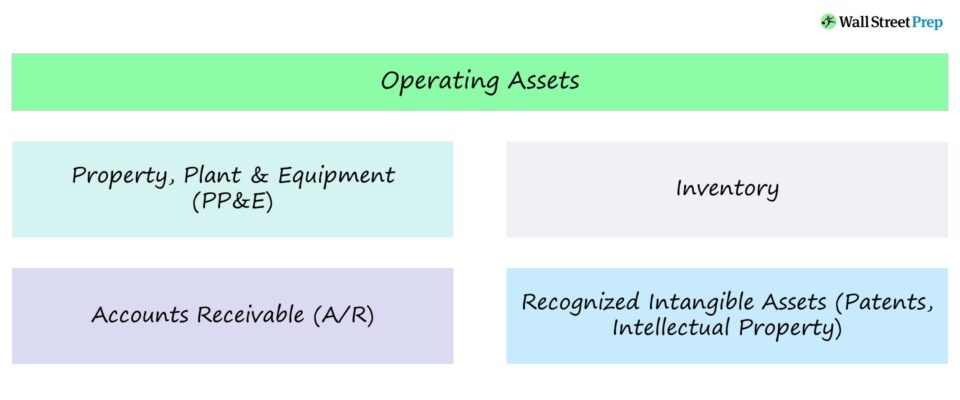What are Operating Assets?
Operating Assets are necessary to a company’s ongoing core operations and directly support the continued generation of revenue and profits.

What is the Definition of Operating Assets?
Operating assets have an integral role in the core business model of a company.
Operating assets refer to a specific sub-group of assets that, on behalf of the company, generates revenue and supports the core business operations (and day-to-day functions).
If an asset is required for day-to-day operations to sustain itself, it is most likely an operating asset since its contribution is essential for the company to continue running its operations and producing revenue.
In practice, the most common examples of operating assets include the following:
- Property, Plant & Equipment (PP&E), or Fixed Assets
- Inventory
- Accounts Receivable (A/R)
- Recognized Intangible Assets (e.g. Patents, Intellectual Property)
Operating Assets Formula
The value of a company’s operating assets is equal to the sum of all assets minus the value of all non-operating assets.
Where:
- Total Assets → Current Assets + Non-Current Assets
- Non-Operating Assets → Cash and Cash Equivalents, Marketable Securities
Operating Assets vs. Non Operating Assets: What is the Difference?
Unlike operating assets, non-operating assets are not considered a core aspect of operations.
Even if the asset produces income for the company, the stream is considered “side income”.
Marketable securities and related cash equivalents are examples of non-operating assets, regardless of the income generated by these types of low-risk investments.
Financing assets are indeed assets with positive economic value but are classified as non-core assets.
The monetary benefit provided by these assets comes in the form of interest income, yet a company could hypothetically continue conducting business as usual even if these securities were to be liquidated.
Hence, line items such as interest income and dividends are separately broken out on the income statement within the non-operating income / (expenses) section.
How to Determine the Value of Operating Assets?
Operating Assets in Intrinsic Valuation (DCF)
When estimating the value of an asset such as a company, the valuation should isolate and reflect only the company’s operating, core assets.
In the case of intrinsic valuation – most often via the discounted cash flow (DCF) model – the free cash flow (FCF) calculation should include just the inflows / (outflows) of cash from the recurring operations of the company.
As a result, a company’s financials must be adjusted to exclude non-operating income, which stems from non-operating assets, and is a crucial step to accurately forecasting a company’s future performance.
The projected FCFs must strictly come from the company’s recurring operations; otherwise, the implied valuation loses credibility.
Learn More → Enterprise Value Primer
Periodic Acquisitions vs. Capital Expenditures (Capex)
For example, the impact of periodic acquisitions should be removed, due to being one-time, unforeseeable events.
On the other hand, capital expenditures (CapEx) are practically always included when calculating the FCFs of a company because PP&E purchases represent “required” spending.
Operating Assets in Relative Valuation (Comps Analysis)
As for relative valuation, the objective is to value the operations of a company based on that of its peers, also making it necessary to focus solely on the core operations to properly determine the valuation of the target.
If not, discretionary decisions made by management (e.g. purchasing short-term investments) are included in the comps-derived valuation.
When spreading comps – whether comparable company analysis or precedent transactions analysis – the aim should be to isolate the core operations of each company in the peer group.
Doing so allows the comparisons among peers to be as close to “apples to apples” as possible.

Everything You Need To Master Financial Modeling
Enroll in The Premium Package: Learn Financial Statement Modeling, DCF, M&A, LBO and Comps. The same training program used at top investment banks.
Enroll Today




